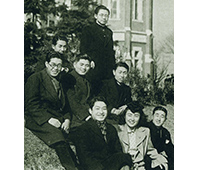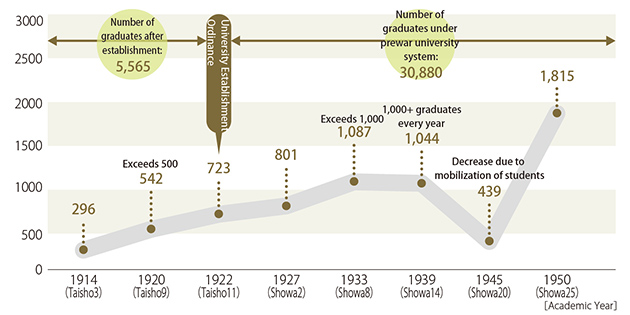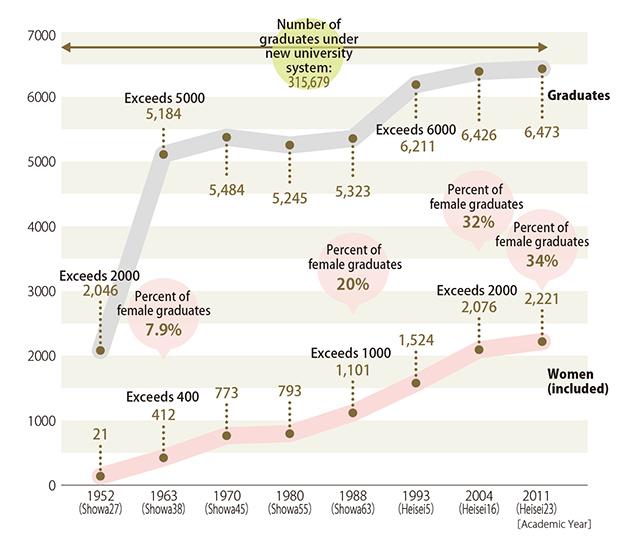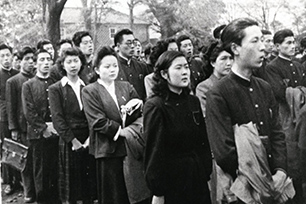Tracing the History of Student Numbers at Keio University Hundredfold increase in student population in just over 120 years
This year marks 155 years of Keio Gijuku, since Yukichi Fukuzawa first began his school for Dutch studies in 1858. From the late Tokugawa shogunate of the Ansei era to the current Heisei era, we will shed light on the history of "numbers" at Keio University, on how student numbers shifted, and when female students were first admitted to the university.
![Keio Students (c. 1872-77 [Meiji 5-10])](/en/keio_in_depth/keio_view/2013/t0f9o4000000a4pb-img/t0f9o4000000a4u9.jpg)
Student numbers around 100 at the naming of Keio Gijuku
![Keio Gijuku School Building (c. 1890 [Meiji 23])](/en/keio_in_depth/keio_view/2013/t0f9o4000000a4pb-img/t0f9o4000000a4v5.jpg)

It was in 1858 (Ansei 5) that Yukichi Fukuzawa opened his school for Dutch studies at the residence of the Nakatsu Domain in Tsukiji Teppozu. At first, it seems that his students were few in number and his school focused primarily on teaching Dutch studies to the sons of retainers from the Nakatsu Domain. However, their numbers progressively increased when Fukuzawa, who emphasized Japan's relationship with the United States and Britain, switched the focus of his school from Dutch to English after the signing of the Ansei Five-Power Treaties. By 1867 (Keio 3), student numbers hovered between 80 and 100.
Though numbers waned amid the Boshin War, Fukuzawa deemed it a momentary disturbance and proceeded with construction on a new school building in Shiba Shinsenza, which was to assume the name Keio Gijuku in April of 1868 (Keio 4). Just as Fukuzawa expected, student numbers swelled in the early Meiji period following the war, easily exceeding 100 students. The Shiba Shinsenza school became so crowded that branch schools had to be established at the residence of the Okudaira family of the Nakatsu Domain in Shiodome and at Ryugen-ji in Mita Furukawabashi.
When the school moved to the former residence of the Shimabara Domain in Mita in 1871 (Meiji 4), there were around 300 students, and by the time of the two-story Rengakodo Auditorium's construction in 1886 (Meiji 19), there were already 1,000 students. On the hill of Mita, new school buildings were built one after another to accommodate ever increasing student numbers.
In 1890 (Meiji 23), Keio established a three-year university system. The inaugural class included twenty-five students of literature, eight students of law, and twenty-eight students of political economy.
Transition of graduating numbers from 1914 to the present


The total number of graduates of this university from its establishment to the implementation of the University Establishment Ordinance in 1922 (Taisho 11) was 5,565. If we look at the graduate numbers for each year, 296 students graduated in 1914 (Taisho 3) and continually increased after Keio's designation as a university under the ordinance, exceeding 1,000 graduates every year since 1939 (Showa 14) with the exception of 1945, when students were mobilized during the war.
After the war, the Fujiwara Institute of Technology, donated to Keio University in 1944, became the Faculty of Engineering (now the Faculty of Science and Technology) and in 1957 the Faculty of Business & Commerce was established. Due in part to these expansions, in 1963 (Showa 38) the number of graduates exceeded 5,000 for the first time with 5,184 graduates. The total number of graduates has exceeded 6,000 since the Faculty of Policy Management and the Faculty of Environment and Information Studies opened their doors in 1993 (Heisei 5), and that number is nearing 6,500 with the addition of the Faculty of Nursing and Medical Care and the Faculty of Pharmacy.
In just over 120 years' time, the number of first-year students is now over 100 times larger than that of the inaugural class of 61 students in 1890.
First official female Keio students admitted in postwar period and currently make up one-third of student population

There are many interpretations as to the very first female student at Keio.
As a place of practical education, Keio Gijuku Tailoring School was established in 1872 (Meiji 5) to teach sewing as well as reading, writing, and arithmetic, and the Department of Medicine's Nursing School was founded in 1918 (Taisho 7) upon establishment of the department.
As for Keio's affiliated schools, there are records that Fukuzawa's daughters attended Wada-juku (now Keio Yochisha Elementary School) in 1879 (Meiji 12); however, the Yochisha only became officially co-educational the year after the establishment of Keio Chutobu Junior High School in 1948 (Showa 23). Two years later, Keio Girls Senior High School was established and an all-girls' education system was rapidly put into place.
Keio University admitted its first official female students in April 1946 (Showa 21). However, the first female graduate was a non-degree student who was granted admission as a regular student after passing the transferee admissions examination. She graduated in 1946 (Showa 21) from the Faculty of Literature though admissions system itself for non-degree female students had been in place since 1938 (Showa 13).
Female students gradually increased (see graph), and out of the 6,473 students of the 2011 graduating class, 2,221 were women, or 34%.
*Photos courtesy of Fukuzawa Memorial Center for Modern Japanese Studies.
